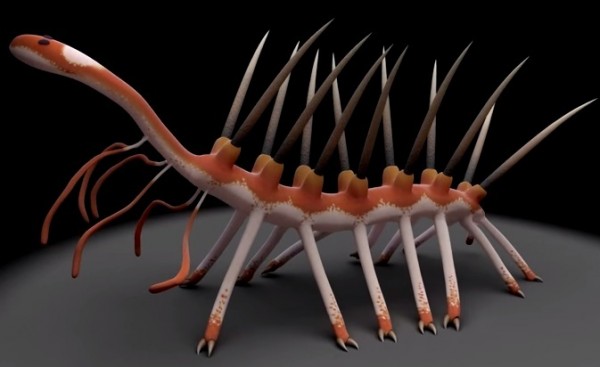Smiling Worm Facts: 5 Things You Need To Know About This Tiny, Spiky Creature
| KJ Belonio | | Jun 25, 2015 03:20 PM EDT |
(Photo : You Tube/NPG Press) The Hallucigenia has been first identified by scientists back in the ‘70s. However, its bizarre anatomy gave scientists a hard time figuring out which end of the Smiling worm was its head and which was the tail.
Smiling Worm Facts - Decades after its fossils left scientists baffled, a new study has recently solved the mysterious case of the odd ancient worm Hallucigenia or better known as the "smiling worm."
Like Us on Facebook
The Hallucigenia has been first identified by scientists back in the '70s. However, its bizarre anatomy gave experts a hard time figuring out which end of the smiling worm was its head and which was the tail. But thanks to a new study of Hallucigenia fossils published on the journal Nature, researchers were able to shed some new insight on its primitive mouthparts.
"With the new description, you can imagine Hallucigenia looking a bit like a caterpillar but with really long, flimsy, extensible legs, and these pairs of conical spines running along its back," England's University of Cambridge paleontologist and lead study author Dr. Martin Smith said. "So it sort of looks like a twig with loads of sticks coming out of it."
As researchers finally solved the long-drawn-out mystery about the Hallucigenia worm, we are sharing 5 interesting things to know about this tiny, spiky creature called as smiling worm.
1. Hallucigenia worms were tiny marine worms, usually measuring between 10 to 15 millimeters in length. These strange smiling worms emerged during the Cambrian Explosion. According to The Telegraph, the Cambrian era is a the first Paleozoic Era (the "time of ancient life") geological time period of rapid evolutionary development that began almost 500 million years ago, when most major animal groups first emerge in the fossil record.
2. Hallucigenia worm has a circular "grinning" mouth lined with teeth, CBS News revealed. This toothy ring may be the connection that links diverse creatures such as spiders, nematode worms, mud-dwelling Loricifera, phallus-shaped "penis worms" and teeny-tiny tardigrades or water bears, which are cute and almost indestructible micro animals.
3. These Smiling worms (Hallucigenia sparsa) are ancestors of modern-day velvet worms, Live Science noted. While the Hallucigenia worms have long, wormy body with spines on top and 10 pairs of spindly legs ending in claws and three pairs of tentacles along its neck, the velvet worms are strange, sluglike creatures with centipede-style legs.
4. The analysis of its 500-million-year-old fossil also suggests that Hallucigenia must have had a small mouth cavity in front of a ring of teeth to suck food into its throat. As per Huffington Post, the throat would have been lined with tiny needlelike teeth to push the food into the stomach.
5. The fossils of the smiling worms originated in the Burgess Shale of Yoho National Park in western Canada, one of the world's richest sources of fossils from the Cambrian period.
TagsSmiling Worm, Science, discovery, Hallucigenia
©2015 Chinatopix All rights reserved. Do not reproduce without permission
EDITOR'S PICKS
-

Did the Trump administration just announce plans for a trade war with ‘hostile’ China and Russia?
-

US Senate passes Taiwan travel bill slammed by China
-

As Yan Sihong’s family grieves, here are other Chinese students who went missing abroad. Some have never been found
-

Beijing blasts Western critics who ‘smear China’ with the term sharp power
-

China Envoy Seeks to Defuse Tensions With U.S. as a Trade War Brews
-

Singapore's Deputy PM Provides Bitcoin Vote of Confidence Amid China's Blanket Bans
-

China warns investors over risks in overseas virtual currency trading
-

Chinese government most trustworthy: survey
-

Kashima Antlers On Course For Back-To-Back Titles
MOST POPULAR
LATEST NEWS
Zhou Yongkang: China's Former Security Chief Sentenced to Life in Prison

China's former Chief of the Ministry of Public Security, Zhou Yongkang, has been given a life sentence after he was found guilty of abusing his office, bribery and deliberately ... Full Article
TRENDING STORY

China Pork Prices Expected to Stabilize As The Supplies Recover

Elephone P9000 Smartphone is now on Sale on Amazon India

There's a Big Chance Cliffhangers Won't Still Be Resolved When Grey's Anatomy Season 13 Returns

Supreme Court Ruled on Samsung vs Apple Dispute for Patent Infringement

Microsoft Surface Pro 5 Rumors and Release Date: What is the Latest?










